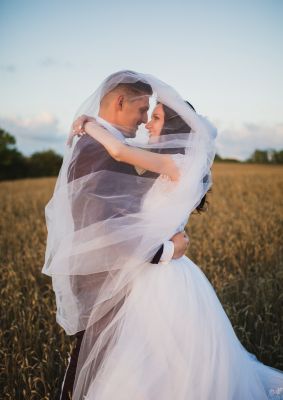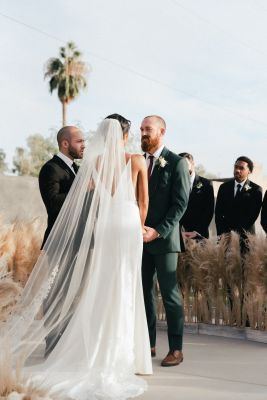Veils are one of the most iconic elements of a bride’s outfit. There’s no doubting their beauty, or their firm place in wedding traditions. But, we do have one question - why do we actually wear veils at weddings?
Veils are absolutely beautiful accessories. They are made with extreme care and delicacy, come in a vast array of different styles and designs, and cost a small fortune.
The soft, sheer fabric gives the bride’s outfit a fairytale feel, and marks the wedding as completely separate from any other occasion. It’s easy to see why they have such a beloved, time-honoured place in wedding day traditions.
But, when you think about it, veils are actually a pretty strange concept. Not only are you decorating your head with a piece of delicate, elaborately designed fabric, but you can only wear them on this one day of your life. It’s not like fascinators or pocket watches; equally elaborate accessories, which you also see at Ascot and posh dinners.
So, why do we wear veils at weddings? Where did this tradition come from, and what different types of veils exist?
We’ve answered all of these questions (and more) below. Keep reading to find out more about the tradition of wearing veils, what veils are typically used for in weddings, our favourite examples of modern veil designs, and our top tips for choosing the perfect wedding veil.

When did brides start wearing veils at weddings?
The tradition behind veils will really surprise you.
Interestingly, the tradition started in the Roman period. But, instead of the understated, modest white veil that have characterised weddings for hundreds of years, the Romans used a bright red sheet.
This was called a ‘flammeum’ and the fabric completely covered the bride. As the name suggests, the flammeum was designed to make the bride look like she was on fire, so that evil spirits would be scared away from the ceremony.
Evil spirits were a pretty major concern for the Romans, and this belief led to the creation of a number of the wedding traditions that we still use today (although not for the same reason). In fact, bridesmaids were also seen in Roman weddings, but their job was to distract evil spirits away from the bride - they were essentially bait!
Although it started with red fabric, the veil eventually became white as, instead of using it to make the bride look like she’d caught fire, Romans used veils to hide brides from these spirits. This also coincided with the tradition of the groom not seeing the bride’s face until the ceremony had finished.
Over time, the bride’s disguise (i.e. veil) was lifted by her father - a tradition which came to represent the ownership of and responsibility for her being passed from the father to the husband.
What are veils used for at weddings?
Although modern brides are a lot less scared of being attacked by these pesky demons, the tradition of wearing wedding veils still remains today.
And, although the idea of passing ownership has definitely not aged well, the lifting of the veil is still a common part of the ceremony.
Instead, the veil is often lifted by the bride or groom, either after she has walked down the aisle, or once they have said ‘I do’ - it’s entirely up to you. The superstition that it’d be bad luck for a groom to see the bride before the ceremony has definitely stuck, and it’s this that gives the lifting of the veil its symbolic place in a wedding.
A number of brides choose not to wear veils that cover their face, opting for veils that can be pinned behind their heads.
In some cases, if the veils are super long, then the bride might ask her bridesmaids or flower girl to carry the veil behind her as she walks down the aisle.
If none of the above apply, then the veil can simply exist as a beautiful accessory, giving the gown an extra touch of glamour.

Our favourite examples of modern wedding veils?
As the old saying goes, rules are made to be broken.
Just because veils are an old wedding tradition, that doesn’t mean you can’t put your own spin on the accessory. If a classic, long white veil doesn’t quite match your style, you can still feature this tradition in your ceremony, while recreating it to match your vibe.
Here are our 5 favourite ways that modern brides have reinvented traditional wedding veils:
- Floral veils. You can buy wedding veils that have bold, multi-coloured flowers stitched onto the veil fabric. This gives the bride’s outfit a beautiful, vibrant-yet-natural effect. Alternatively, you can even buy wedding veils that feature colourful, pressed real flowers.
- Super-short veils. If you don’t fancy a long, trailing veil, choose a shorter option! You can buy chic short veils, which consist of a small share of fabric, shaped into a geometric style. This gives the bride’s outfit an elegant, French feel.
- Birdcage veils. Instead of using a fine mesh (as is traditional), these veils use netting with much larger holes and thicker fabric strands. The effect is not dissimilar to fishnet tights, but the result is a chic, Channel-esque accessory for a bridal outfit.
- Colourful veils. Whoever said that veils need to be white? Soft greys, blues, pinks and greens are popular options for coloured veils.
- Headdresses. Or, instead of a veil, you could choose an elaborate headdress. Some brides choose fabric headbands which use long lengths of fabric (to replicate the effect of the veil). Others choose elaborate metal headpieces and fascinators.
Our top tips for choosing the perfect veil to match your wedding dress
You may think that finding a veil is simple. They’re just a piece of white fabric, right? Wrong!
You’ll be amazed by the sheer number of veils out there, in every length, style, cut, design and effect conceivable.
If you want to include a veil in your wedding outfit, here are our top 8 tips to help with your search:
- Carefully consider your venue. Will there be mud? Are you outside or inside? If you’re likely to be outside for the bulk of the day, then a long veil probably isn’t the best fit for you.
- Think about the itinerary. Will there be lots of dancing? Do you have games planned? Will you be walking around a lot? If the answer to any of the above is ‘yes’, you can probably rule out a long veil. Remember, your dress should be made to fit you, not the other way round.
- To gather or not to gather? There are three options for veil gathering styles. These are fully gathered, centre gathered and ungathered. Do your research, and find out which you like best.
- Single or double layer? The former is simple and elegant, the latter adds an extra touch of glamour.
- Do you want to include a headpiece? If you want both a veil and a headpiece, you will need to choose a veil that can attach to a headpiece, and the two will need to complement each other.
- Consider embroidery designs. If you want to take your veil down the more ornate route, there’s a huge range of different embroidery designs out there for you to browse. You could choose delicate flowers, polka dots, or thick, ornate embroidery.
- Would you like your veil to have a comb attached? Most veils come with a comb attached (for easy use), but some styles don’t come with a comb. If you are choosing an un-gathered drop or mantilla style veil these may not come with a comb, so this may be something that you want to take into consideration.
- Research different edging finishes. The most common edging finishes are a hand cut edge, lace edge, scalloped edge, ribbon edge, pencil edge, rhinestone edge, pearl edge, satin binding edge, wired edge and a corded edge.
Even though you’re probably not using it to pretend to be on fire, veils are still a stunning inclusion to a bridal outfit. The icing on the majestic white cake, if you will.
There’s no other accessory quite like it.




